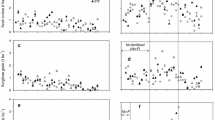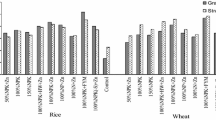Abstract
Decline in soil fertility accelerated by shorter fallow periods was expected to be a major constraint in slash-and-burn rice production systems in northern Laos. In this paper we describe relationships between fallow period, soil fertility parameters, weeds and rice yield. Soil infertility is not perceived a major yield constraint by the farmers. Of the various soil parameters observed only soil organic matter showed consistent association with rice yield (r=0.42, p<0.01). Fallow period and rice yield showed no association and the relationship between fallow and organic matter was very weak (r=0.16, p<0.01). Rice yield was negatively related to densities of Ageratum conyzoides and Lygodium flexuosum. Soil loss during the cropping period ranged from 300–29.300 kg ha−1. For the same period organic matter, total N, available P and available K content in the top 0–3 cm decreased by 11,12,17, and 17%, respectively, and loss of total N for the soil depth of 0–25 cm was estimated at 400 kg ha−1. Soil physical properties, moisture stress and available N are the most likely detriments to rice yields. Further attempts to relate soil properties to rice yield should include repeated measurements during the cropping season and observations on soil physical properties.
Similar content being viewed by others
References
Andriesse J P and Schelhaas R M 1987 A monitoring study of nutrient cycles in soils used for shifting cultivation under various climatic conditions in Tropical Asia. II. Nutrient stores in biomass and soil-results of baseline studies. Agric. Ecosyst. Environ. 19, 285–310.
Brubacher D, Arnason J T and Lambert J D H 1989 Woody species and nutrient accumulation during the fallow period of milpa farming in Belize, C.A. Plant and Soil 114, 165–172.
ESCAP 1990 Atlas of mineral resources of the ESCAP region Vol. 7. Lao People's Democratic Republic. United Nations, New York.
FAO/IINESCO 1974 Soil Map of the World. FAO, Rome.
Fujisaka S 1991 A diagnostic survey of shifting cultivation in northern Laos: targeting research to improve sustainability and productivity. Agrofor. Syst. 13, 95–109.
Gourou P 1942 L'utilisation du sol en Indochine. Centre d'études de politique étrangère, Paris.
Jordan C F 1985 Nutrient cycling in tropical forest ecosystems. John Willey and Sons, New York.
Kyuma K, Tulaphitak T and Pairintra C 1985 Changes in soil fertility and tilth under shifting cultivation. I. General description of soil and effect of burning on soil characteristics. Soil Sci. Plant Nutr. 31, 227–238.
Lovelace G W 1991 Designing a development strategy for Sepone: some observations regarding goals, approaches and technologies. In Swidden agroecosystems in Sepone District Savannakhet Province, Lao PDR. Report of the 1991 SUAN-EAPI-MAF Agroecosystem Research Workshop Savannakhet Province, Lao PDR. SUAN Secretariat Khon Kaen University, Khon Kaen. pp 133–135.
Lugo A E and Brown S 1993 Management of tropical soils as sinks or sources of atmospheric carbon. Plant and Soil 149, 27–41.
Moody K 1974 Weeds and shifting cultivation. FAO Soils Bull. 24, 155–166
Nye P H and Greenland D J 1960 Commonwealth Bureau of Soils Technical Communication No. 51. Commonwealth Agricultural Bureau, Farnham, England.
Nye P H and Greenland D J 1964 Changes in the soil after clearing tropical forest. Plant and Soil 21, 101–112.
Page A L, Miller R H and Keeney D R 1982 Methods of Soil Analysis, Part 2, ASA Monograph No. 9. ASA, Madison, WI, USA.
Phouaravanh B, Roder W, Inthapanya P and Vannalath K 1994 Traditional upland rice varieties in Laos. In Shifting Cultivation and Rural Development in the LAO PDR. pp 170–175. Report of the Nabong technical meeting, Nabong College, Vientiane.
Pushparajah E and Bachik A T 1985 Management of acid tropical soils in Southeast Asia. In Management of Acid Tropical, Soils for Sustainable Agriculture. Proc. IBSRAM inaugural workshop, Brasilia. pp 13–39.
Roder W, Keoboualapha B and Manivanh V 1995a Teak (Tectona randis), fruit trees and other perennials used by hill farmers of northern Laos. Agrofor. Syst. 27, 1–14.
Roder W, Phengchanh S and Soukhaphonh 1995b Estimates of variation for measurements of selected soil parameters on slash-and-burn fields in Northern Laos. Commun. Soil Sci. Plant Anal. 26 (In press).
Roder W, Soukhaphonh H, Phengchanh S and Vannalath K 1992 Recent research activities in upland rice farming systems of Luang Prabang, LAOS. Rice Farming Systems Technical Exchange, 2, 10–13.
Roder W, Phouaravanh B, Phengchanh S, Keoboualapha B and Maniphone S 1994 Upland agriculture—Activities by Lao-IRRI Project. In Shifting Cultivation and Rural Development in the LAO PDR, Report of the Nabong technical meeting, Nabong College, Vientiane. pp 152–169.
Rural micro-projects 1992 Options for upland soil conservation. Technical Report No. 6. Rural micro-projects, Luang Prabang, Laos.
Sanchez P A 1976 Properties and Management of Soils in the Tropics. John Wiley and Sons, New York.
Sanchez P A 1987 Management of acid soils in the humid tropics of Latin America. In Management of Acid Tropical, Soils for Sustainable Agriculture. Proceedings of an IBSRAM inaugural workshop, Bangkok. pp 63–107.
Sanchez P A and T J Logan 1992 Myths and science about the chemistry and fertility of soils in the tropics. In Myths and Science of Soils of the Tropics. Eds. R Lal and P A Sanchez. pp 35–46. SSSA Special Publication no. 29, Madison, WI, USA.
SUAN 1990 Two upland agroecosystems in Luang Prabang Province, Lao PDR: A preliminary analysis. SUAN-Lao seminar on rural resource analysis, Vientiane and Luang Prabang, Lao PDR. SUAN Secretariat, Khon Kaen Univ., Khon Kaen.
Tulaphitak T, Pairintra C and Kyuma K 1985 Changes in soil fertility and tilth under shifting cultivation. II. Changes in soil nutrient status. Soil Sci. Plant Nutr. 31, 227–238.
Warner K 1991 Shifting cultivators—local technical knowledge and natural resource management in the humid tropics. Community Forestry Note 8. FAO, Rome. 80p.
Author information
Authors and Affiliations
Additional information
The research presented was supported by the Provincial Agriculture Service, Luang Prabang, Laos, and the Swiss Development Cooperation.
Rights and permissions
About this article
Cite this article
Roder, W., Phengchanh, S. & Keoboulapha, B. Relationships between soil, fallow period, weeds and rice yield in slash-and-burn systems of Laos. Plant Soil 176, 27–36 (1995). https://doi.org/10.1007/BF00017672
Received:
Accepted:
Issue Date:
DOI: https://doi.org/10.1007/BF00017672




